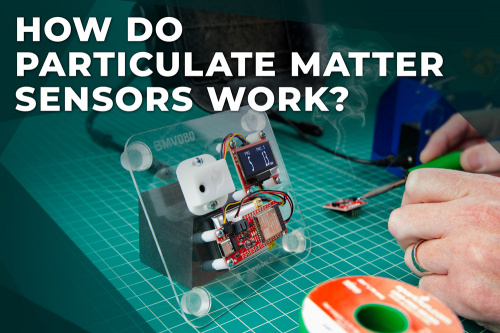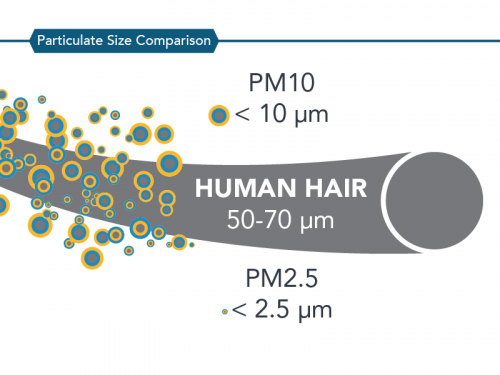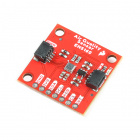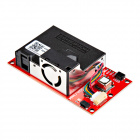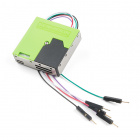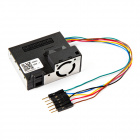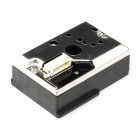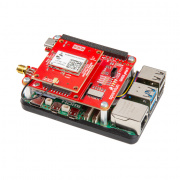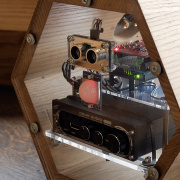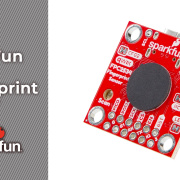How Do Particulate Matter Sensors Work?
Let's explore the tiny world of particulate matter!
We recently released a very cool particulate matter sensor - The SparkFun Air Quality PM1/PM2.5/PM10 Sensor - BMV080 based on the incredibly miniscule BMV080 from Bosch Sensortec, which is 450 times smaller than comparable devices on the market. In the wake of this release's popularity, we've had plenty of questions asking about the underlying technology behind particulate matter sensors and what ranges particle size detection are needed for what applications. Let's get into it!
What is Particulate Matter?
First off, we should define what data it is that we are gathering. Particulate Matter (referred to as PM) are microscopic molecules suspended in the air. They can be solids or liquids, and they can have impacts on the climate and human health. These particles can come from a variety of sources, including but not limited to; fossil fuel burning, cooking, construction, microplastics, disaster events, and agriculture.
An aerosol is a mixture of particulates and air as opposed to particulate matter alone, so a lot of information about particulates also uses the term. When you hear "aerosol" you're probably thinking of hairspray or spray paint, but aerosols aren't necessarily man-made - it just means air and particulates together. Natural aerosols can come from many sources and aren't necessarily toxic; for example, sea spray is considered an aerosol.
PM is divided into classifications by particle size: PM1, PM2.5, and PM10. Let's get into what these labels mean!
PM1 - Ultrafine Particles
Ultrafine particles have diameters under 1μm, and most of it is dust. Since they are so small, not much is understood about them yet, but we do know that they can penetrate the human body and may pose a health threat. While some PM1 is naturally occuring (like sea spray), much of it comes from combustion activities, similar to PM2.5.
PM2.5 - Fine Particles
Fine particles have diameters between 1 and 2.5μm, and are so fine that they are capable of entering our lungs and even our blood! PM2.5 can come from natural or man-made sources, like vehicle exhaust, power plant emissions, or wildfires.
PM10 - Coarse Particles
These particles are the largest of the list - they're coarse compared to the others, but still inhalable. They have diameters between 2.5 and 10 μm. Types of particles that are considered PM10 are mold spores, bacteria, dust, smoke, and some viruses.
Why Do We Care About PM?
Airborne PM is considered a Group 1 carcinogen, which means it has properties that are known to be cancer-causing in humans. They can penetrate the human body and can enter your lungs and bloodstream. Particulates are the most harmful form of air pollution, and have been shown to contribute to heart disease, lung disease, cancer and premature births. PM2.5 have been shown to be the most problamatic range of particulate matter as they are the most likely to travel into and deposit onto the deeper parts of the lungs.
Being able to monitor PM levels in your home, work, or any other enclosed space means you can monitor how safe your air is, and take action to improve your air quality if you detect PM. The World Health Organization has established guidelines for recommended levels of PM, and you can also consult this interactive air quality map to see the concentration of PM2.5 in your area, or check out Purple Air's live air quality map for an impressive display of crowd-sourced data (as a side note - if you're interested in reading about it, we have proudly worked with purple air for a number of years).
What Are the Types of PM Sensors?
There are two main types of PM sensors - infrared and laser. They both use different properties of light to measure the concentration and size of particles in the air.
IR Sensors
Infrared (IR) particulate matter (PM) sensors work by emitting an infrared light beam into a sample of air, and then measuring the amount of light scattered by particles within that air. The intensity of the scattered light is directly related to the concentration of particulate matter in the air, allowing the sensor to determine the levels of PM.
Laser Sensors
A laser particulate matter (PM) sensor measures air quality by shining a laser beam through a sample of air and detecting the scattered light caused by particles. The sensor then analyzes the intensity and angle of the scattered light to determine the concentration and size of the particles.
SparkFun PM Sensors
More Reading:
- https://www.epa.gov/pm-pollution/particulate-matter-pm-basics
- https://ww2.arb.ca.gov/resources/inhalable-particulate-matter-and-health
- https://learn.kaiterra.com/en/resources/three-types-of-particulate-matter
- https://www.c40knowledgehub.org/s/article/Air-Quality-Data-Explorer?language=en_US
